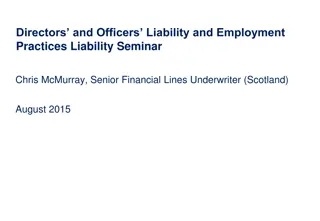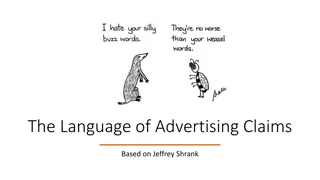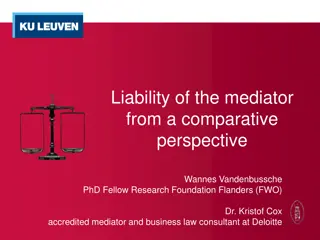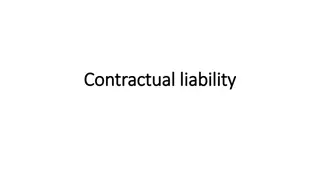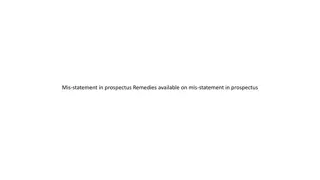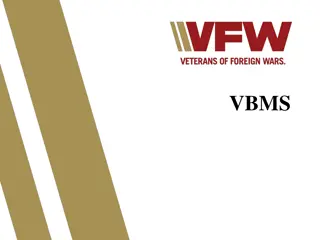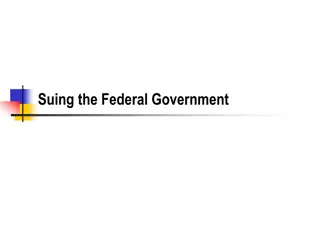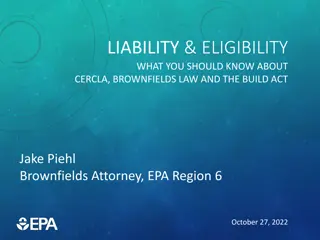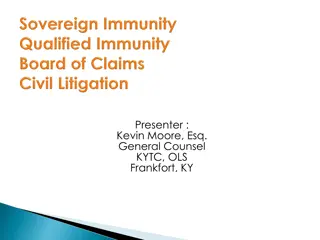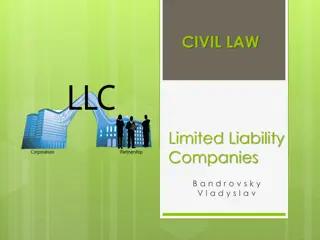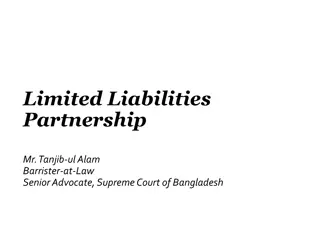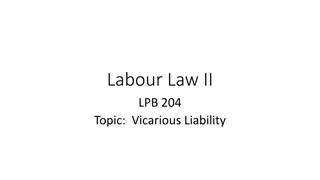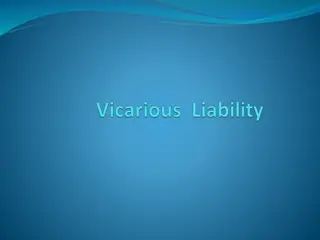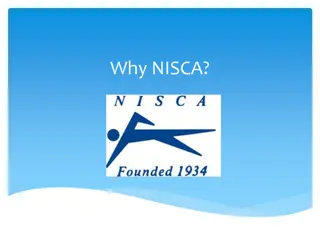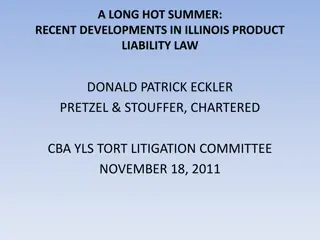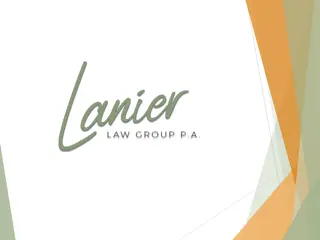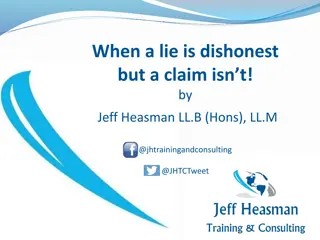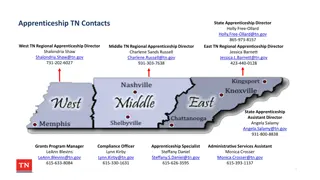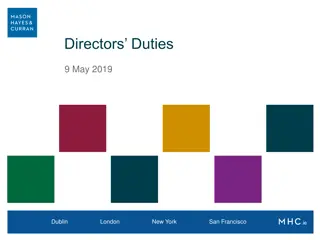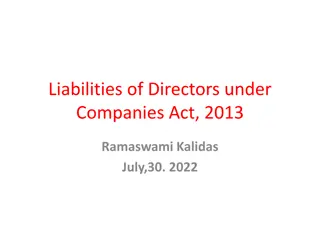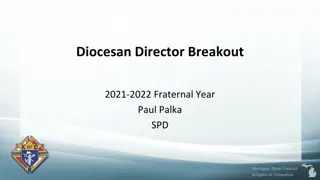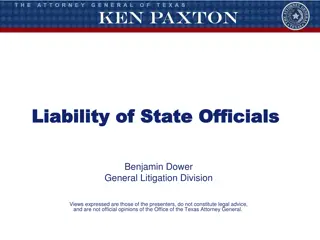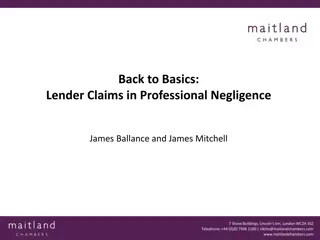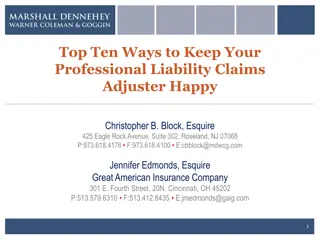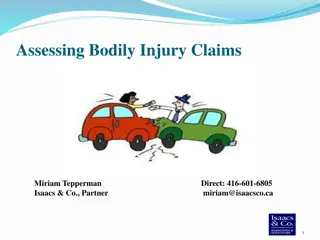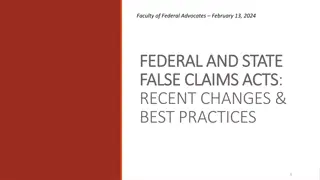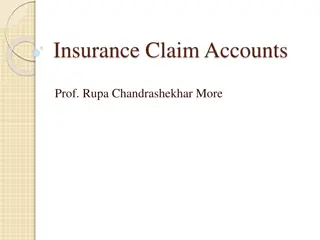Directors in the Twilight Zone: Trends and Perspectives in Liability Claims
Explore the evolving landscape of director liability claims in the Netherlands and beyond, delving into concepts like insolvencification, CJEU rulings, and the risks of opportunistic behavior. Discover how countries like Belgium are following the trend, while the Netherlands navigates the classification of mismanagement liability. Unveil the impact of CJEU Kornhaas case on cross-border director claims.
Download Presentation

Please find below an Image/Link to download the presentation.
The content on the website is provided AS IS for your information and personal use only. It may not be sold, licensed, or shared on other websites without obtaining consent from the author. Download presentation by click this link. If you encounter any issues during the download, it is possible that the publisher has removed the file from their server.
E N D
Presentation Transcript
| 1 | 1 Directors in the twilight zone Kornhaas and beyond A view from the Netherlands Loes Lennarts
| 2 Outline 1. Some remarks on insolvencification 2. CJEU Kornhaas 3. Risks of opportunistic behaviour in the twilight zone 4. Overview of director liability claims available to liquidator under Dutch law 5. Liability for payments made after moment of truth 6. Beyond Kornhaas: perspectives for harmonization?
| 3 Trend: insolvencification After CJEU Inspire Art: Realisation that domestic company law is not to be applied to companies from other MS (exception: Gebhard: non-discriminatory, public interest, suitable and proportionate) Tendency to re-classify creditor protecting mechanisms as insolvency law example Germany 2008: duty to file [and subordination of shareholder loans])
| 4 Trend: insolvencification Used as tool by MS to apply domestic liability provisions to directors of foreign companies with local COMI Insolvencification is not unproblematic: It clashes with free choice of company law (mere relabeling can not be enough to avoid art. 49/54 TFEU) It can lead to cumulation of provisions protecting creditors (insolvency law is applied regardless of remedies in company law)
| 5 Belgium is following the trend: Proposed revision of Belgian company law, see http://www.bcv-cds.be/index.html (only Dutch and French) Belgium will adopt incorporation theory Capital protection regime of 2nd Directive will be abolished for Belgian Ltds Wrongful trading rule will be codified as part of insolvency law
| 6 Netherlands? Liability for mismanagement causing bankruptcy is part of Book 2 DCC (company law) Proposal to shift it to Bankruptcy Code has been withdrawn Insignificant: it should be classified anyhow as insolvency law in the sense of art. 4 EIR
| 7 CJEU Kornhaas (C-594-14) UK Ltd doing business in Germany German liquidator brings claim against director for payments made after moment of truth (par. 64 GmbHG) CJEU rules that: Claim is covered by art. 4 EIR (and applies as part of lex concursus) (see also C-295/13, H. on jurisdiction) Application to director of UK Ltd not precluded by art. 49/54 TFEU
| 8 CJEU Kornhaas Kornhaas is an open invitation to MS to engage in (further) re-classification (CJEU s decision on free movement aspects has been criticized (e.g. Ringe, Oxford Business Law Blog) It is still not clear which director liability claims are covered by art. 4 (see reasoning of the CJEU in paras 16-21) Revised EIR does not clarify this, see art. 7 recast EIR Result: legal uncertainty
| 9 The Twilight Zone and opportunistic behaviour of shareholders Increased risks of opportunistic behaviour by company controllers, because shareholders: rank last (APR) cannot lose more than their contributions on shares
| 10 The Twilight Zone and opportunistic behaviour of shareholders Risk 1: shifting assets out of the company (transaction avoidance/restriction s on distributions to shareholders) Risk 2: gambling with creditors money when equity is lost (e.g. wrongful trading)
| 11
| 12 Liability of directors Risk 1: Director liability for approving unlawful distributions to shareholders (Art. 2:216(3) DCC (company law) (claim of the company, in case of insolvency IP sues) Director liability based on art. 6:162 DCC (tort law, negligence) for engaging in transactions with shareholders* that harm the company s creditors: - transactions at an undervalue (hidden distributions) - Selective payments (preferences) (IP can bring the claim on the ground that the loss is suffered by the creditors collectively) *or other parties
| 13 Liability of directors Risk 2: continuing to trade after the moment of truth Director liability based on art. 6:162 DCC (tort law, negligence) for reliance loss caused to new creditors (so-called Beklamel-claim, to be brought by individual creditors) Director liability based on art. 6:162 DCC (tort law, negligence) for rate reduction loss caused to the joint creditors (claim to be brought by IP, similar to German Quotenschaden -claim)
| 14 General director liability for mismanagement (art. 2:9 DCC) Improper management Which can be attributed because: serious blame Need to establish causation of loss Joint & several, unless Claim belongs to company, in case of insolvency IP sues Proceeds go to company (in insolvency: estate) This provision applies as part of the applicable company law
| 15 Director Liability for mismanagement causing insolvency (art. 2:138/248 DCC) Manifestly improper management In three year period prior to opening of bankruptcy proceedings Important cause of bankruptcy Presumptions in case of late filing of accounts or improper bookkeeping Joint and several liability for full deficit, unless Only liquidator can bring this claim Proceeds go to the estate This provision qualifies as insolvency law in the sense of art. 4 EIR
2013 LSE study on directors duties and liabilities | 16 Study claims: rules aimed at restricting near- insolvent trading in yellow MS primarily classified as company law Not correct! NL should be blue: mixed approach
Frequent director liability claims in NL insolvency practice | 17 Mismanagement claims brought by the lP, usually based on a number of provisions simultaneously (2:9, 2:138/248 and 6:162 DCC) Beklamel-claims brought by new creditors Tort claims brought by the IP or by an individual creditor against directors for making selective payments on behalf of the company The latter are the KEY director liability issues in rescue attempts as well as in (pre-pack) going concern asset sales
| 18 Liability for selective payments under Dutch law Case law (tort of negligence) Rationale: pari passu principle must be upheld after moment of truth (link with avoidance law: art. 47 DBC) Liability for selective payments to related parties if there are serious reasons to expect a deficit (Supreme Court Coral/Stalt) Selective payments to unrelated parties can lead to liability if there is no reasonable prospect of avoiding bankruptcy Payments may be justified by showing that the payment was part of a feasible turnaround plan
| 19 Compare: par. 64 GmbhG Liability for all payments made by directors after the moment of truth (balance sheet or cash flow insolvency) Rationale: preserving the assets of an insolvent company ( save what can be saved ) (Complement to duty to file (formerly also in par. 64 GmbHG, now par. 15a InsO)) BGH (2014): no liability if company received direct & fair consideration at the time of payment Moreover: no liability if prudent business person would have made the payment
| 20 Case I Dutch BV with COMI in Germany (no establishment in NL), director domiciled in NL Director makes payment when there is no reasonable prospect of avoiding bankruptcy No direct and fair consideration No justification German liquidator can bring par. 64 GmbHG- claim against director before German court (cases Kornhaas and H.) Creditor in the NL can bring claim based on tort law in Dutch court (art. 4 Rome II*; 4(1) Brussels Ibis) *unless excluded from scope, see art. 1(2)d
17-09-2015 | 21 Case I Result: cumulation of claims against the director before courts in different MS BUT: how often do such scenarios occur? We don t really seem to know this (Studies commissioned by EU (2013 LSE and 2016 Leeds Uni) do not offer any insight)
| 22 Case II German GmbH with COMI in NL (no establishment in Germany) Director resides in Germany Director pays dividend to shareholder while knowing that company will not be able to pay debts as they fall due Can liquidator bring a claim in a Dutch court against the director based on art. 2:216 (3) DCC?
| 23 Case II par. 64 GmbHG specifically prohibits payments to shareholders leading to insolvency (illiquidity) of the GmbH (this is the German solvency test for distributions) (this does not apply) [but what if secondary proceedings could have been opened?] However, liquidator may try something else Sue director on basis of tort law (art. 7(2) Brussels Ibis and art. 4 Rome II*, and/or: Claw back distribution from shareholder using transaction avoidance law
| 24 Scenario analysis is necessary These were just two hypotheticals Limited to selective payments And to two MS Many more cases can be designed and analysed Likelihood of such cases occuring in practice would need to be assessed (Only) then possible solutions should be suggested
| 25 | 25 Beyond Kornhaas What can be done in order to streamline insolvency-related director liability claims?
| 26 Synchronising connecting factors for company law and insolvency law Two options : Maintaining current concept of COMI but switching to real seat theory in company law (not feasible) Tying COMI to registered office (Armour, Ringe, Beuerle & Schuster)(not feasible) Note: even if any of these options were feasible, there could still be a clash between applicable company/insolvency law and tort law So: cumulation in Case 1 could still occur
| 27 Adopt a specific conflict rule in EIR Include director liability claims that derive directly from and are closely linked to insolvency proceedings in art. 4 EIR provide for defence similar to art. 13 (Schall, ECFR 2016)? Not so simple: further clarification will be necessary: Proceeds must go to the estate Must (de facto) insolvency be a precondition for claim to arise? Must only liquidator have standing? (Dutch Peeters/Gatzen- claims) Depending on answers to latter questions, certain claims will fall outside scope of art. 4 EIR MS can adapt the law to make certain claims fall within the scope
Substantive harmonisation | 28 Full harmonisation of all insolvency-related director liability claims seems not feasible Choice to make: specific rules aimed at preventing specific behaviour or broad standards? E.g.: Duty to file within specific period of time OR duty to take very reasonable step etc. E.g.: duty to refrain from making (preferential) payments OR duty to act in best interest of creditors Standards give much discretion to courts and do not give clear guidance to directors Rules require MS to compromise
| 29 Substantive harmonisation Meaningful harmonisation requires further study In particular: in-depth analysis of the risks for directors when involved in rescue attempts and reorganisation through going concern sales Not limited to duty to file, but broader (Analyse risks under criminal law) (Look at possibilities to insure risks) Use common denominators to draft rules that give guidance to directors of companies in distress
| 30 Example Regulate director liability for making preferential payments Describe the point in time when the duty to have regard to pari passu kicks in Option: distinguish between paying related/unrelated parties Include possibility to justify the preferential payment because it was made on the basis of a feasible rescue plan OR in order to enable (pre- pack) sale of the business as a going concern Specify requirements the rescue plan must meet
| 31 To all directors in the twilight zone:


